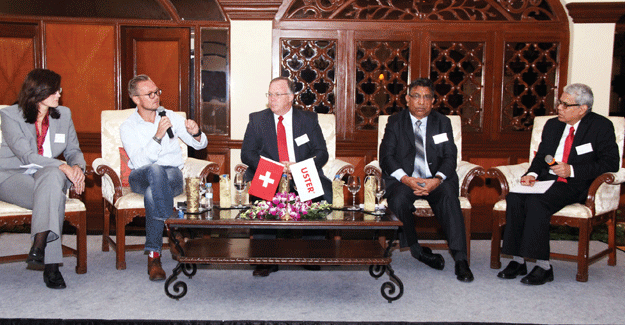
USTER QUALITY UNIVERSITY Was Packed With Expert Insights On Sustainability
The shared experience of top textile executives, a global-scale retail group and the leading provider of textile quality management technology gave a unique insight into the Indian textile industry. Market forecasts, valuable business intelligence and a realistic analysis of problems and solutions combined to draw up a ‘Roadmap for the Future’ for India’s spinning mills, at a special event organised by Uster Technologies. Adaptability, attention to quality issues, value added product mix, sustainable manufacturing and focusing on consumer demands were the key recommendations from a forum of experts. India’s textile industry is already huge and growing with over 50 million spindles installed. And the government has set an ambitious target to boost its share of global textile trade from 5% to 20%. Is that a realistic target? How are Indian spinning mills performing today and what changes are they making in their quest for extra business?
At the third USTER®QUALITY UNIVERSITY held in Goa recently, a group of experts and industry professionals have deliberated on these issues and set out a clear vision for present and future expansion of the industry. V.R. Rathnam, Head Uster Technologies India, lead the expert panel and delivered a practical and authoritative analysis, revealing some often surprising and challenging requirements for successful yarn production. The panel comprised of S.K. Khandelia, President, Sutlej Group; Calvin Woolley, Global Supplier Development Leader, Ikea; Iris Biermann, Head of Textile Technology, Uster Technologies and David McAlister, Product Manager Fiber Testing, Uster Technologies. The event attracted 25 high-level participants, including directors and promoters of 25 mills from all over India. The theme of the event, from February 5 to 7, was ‘Roadmap to the future of the spinning industry in India’. Industry veteran Khandelia provided a deep insight of the key issues and options for Indian spinners today. His experience as the head of a group of mills producing 300 tonnes of yarn per day is significant and he outlined the problems mills face while adapting new market trends. This was often restricted, he said, by the existing plant design and set-up, which prevented innovations that did not fit with the mill’s capabilities. However, dramatic solutions could be found early in his career, when he rescued a 200,000 spindle mill earmark for closure by initiating product diversification instead.
Focusing on exceptions, benchmarking and ROI
Khandelia emphasized the need for focus in managing the business – for example, he now works with only one daily report, compared to numerous documents and papers in the past. He also concentrates only on deviations from the norm in mill production, rather than checking and analyzing ‘good’ results: “If we can handle the exceptions, it is enough,” he said, “but we also know that benchmarking against international standards and best practices is a must, to differentiate our company from competitors.” Ensuring an adequate return on investment was also essential, Khandelia said, and here he revealed his company’s requirement to earn at least 20% ROI – since 11% would be swallowed up by interest. “You can survive one to two years with a loss but not more,” he said. One strategy to cope with instability in raw cotton prices had been to switch towards blends, fancy yarns and mélange yarn to minimize the risk and to complement India’s acknowledged strength in cotton against competition from China and Pakistan by creating a sustainable product mix.
Ikea predicts Indian growth, focus on blends and sustainability
Ikea, the world’s largest furniture retailer, which has strong commitment to cotton and a policy of working closely along the entire production chain joined the USTER®QUALITY UNIVERSITY, and its representative Calvin Woolley forecasted that India has the potential to be the leader in cotton yarn production. For Ikea, spinning is one of the key points in the value chain, Woolley said, but when the cotton price exploded 2011 they had to look for alternatives – especially blends, to which the market thankfully responded more readily than in the past. For the same reason, air-jet and open-end spinning are taking a bigger share of production from ring spinning. Ikea has been sourcing in India for almost 30 years and despite many challenges the company has developed suppliers that are sustainability compliant what Ikea calls its IWAY. Many Indian mills today also suffer from unreliable energy sources, something which is vital for the value chain in yarn production. Ikea is keen to push renewable energy sources and reduce dependence on coal.
Woolley mentioned: “Zero coal demand will come. Not now but it will come and those spinners who are the last to move to renewable energy will be left behind.” A high-level panel dialogue was part of the three-day USTER®QUALITY UNIVERSITY, which also featured a series of workshops and presentations, targeted at improving the knowledge, performance and future prosperity of the sector in today’s increasingly demanding and competitive markets. “In the course of the event, it became clear that key people from leading Indian spinning mills are well-equipped to keep textiles in India as a growing industry, with special importance attached to sustainable products and profits,” said V.R. Rathnam, Head Uster Technologies India.
Textile Excellence
If you wish to Subscribe to Textile Excellence Print Edition, kindly fill in the below form and we shall get back to you with details.








